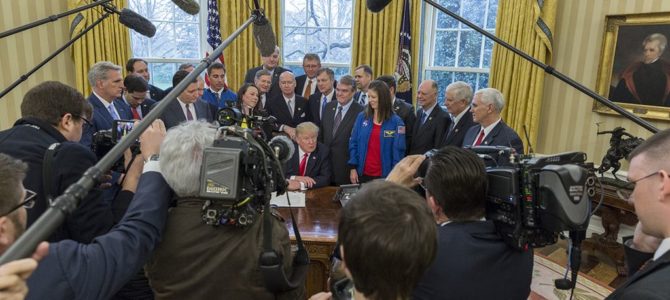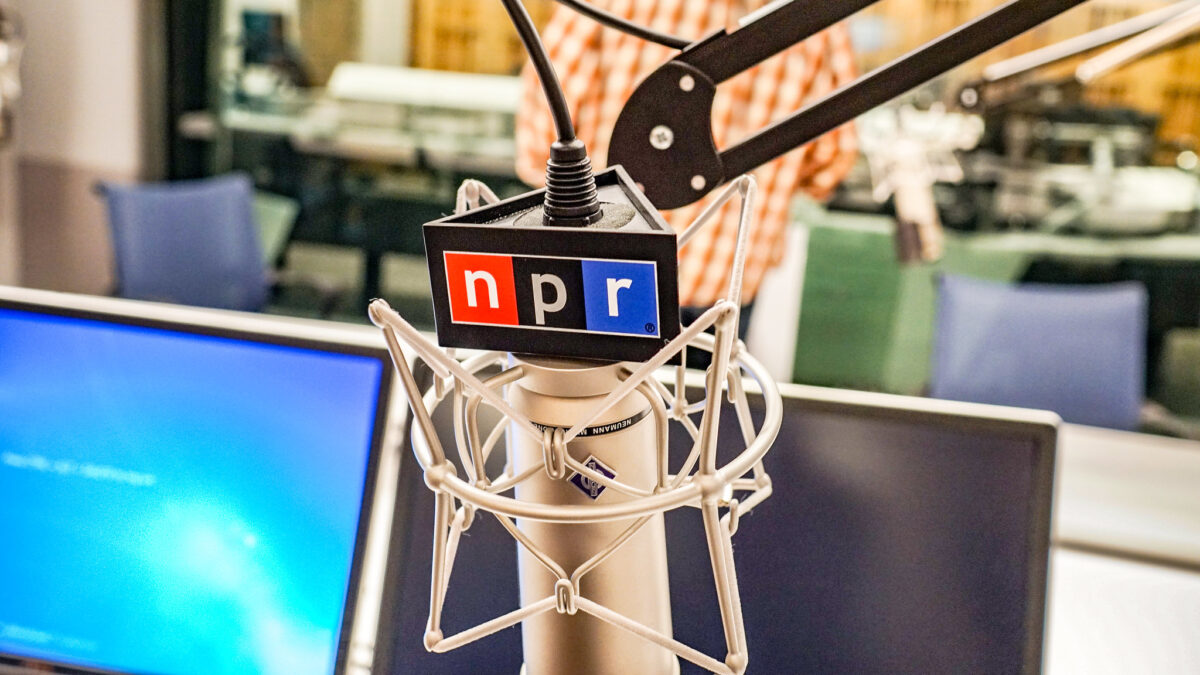
The public sphere is broken. Journalists and public intellectuals persistently read evidence in the darkest possible light and exclude evidence that would put events in their ordinary, less catastrophic context. It’s one of those moments when all bad things are Adolph Hitler, burying worthwhile criticism of power in a blizzard of dumb hyperbole.
Take the president’s criticism of the press, for example, and catastrophize it to meet the current climate of public discussion. Chillingly, Donald Trump tweets stuff about reporters, and makes fun of them from the dais. Nothing like this has ever happened before in the United States, where no previous elected official has ever criticized any journalists.
As the Associated Press put it, after the newly inaugurated President Trump held an apparently terrifying press conference:
Never before has a president stood in the White House and so publicly maligned the press or attacked reporters by name, according to presidential historians. Not even Richard Nixon in the days of Watergate.
‘It was bizarre theater,’ said Douglas Brinkley, a professor of history at Rice University. ‘He turned a presidential press conference into a reality TV show in which he can be the star and browbeat anyone who objects to him with the power of his office.’
Some especially dull-minded politicians have taken this idea to its dumbest extremes, as when the California congressman John Garamendi bluntly said in a CNN interview that Trump has “engaged in rhetoric that slams the press which, by the way, happens to be the very first thing that a dictator will do to secure his position…If one were to look at Nazi Germany, that was the very early part of their tenure was to delegitimize the press.”
Yale University history professor Timothy Snyder, a particularly rabid TrumpHitler caterwauler, has made similar claims—saying, in response to an interviewer’s question about Trump’s criticism of reporters, “of course, it’s an atrocity, and it’s a violation of basic American traditions, to attack journalists like that.”
It’s not. Since (at least) the inception of the American republic, attacks on journalists in the United States have been frequent and furious. Journalists and writers have been killed, threatened with death, beaten, driven out of towns and regions, prosecuted, imprisoned, and forced to watch as their offices were destroyed and their printing presses thrown in the river. There’s a dark and painful history to refer to, and it’s a history other than Hitler, rooted in American soil. We’re in a far less menacing American historical moment than many American journalists have seen in the past. Jim Acosta is not a new and special kind of victim, bless his heart.
Consider What President John Adams Did
Compare the “bizarre theater” of President Trump browbeating journalists in a press conference to the way President John Adams treated Thomas Cooper. The editor of a Pennsylvania newspaper, Cooper wrote and published an essay in 1799 calling Adams a “power-mad despot.” The president told Secretary of State Timothy Pickering that Cooper “ought to be prosecuted.”
And he was, after he published another attack on Adams. Brought to trial in April 1800, Cooper was convicted on a charge of violating the federal Sedition Act, and sentenced to both six months in prison and a $400 fine—at a moment when a pound of butter cost a few cents, and a sergeant in the Marine Corps was paid six dollars a month.
Cooper was one of several newspaper editors the Federalists prosecuted in the last years of the Adams administration. Another, Matthew Lyon, was both an editor and a member of Congress. He spent four months in prison for criticizing the president.
They had it easy. Consider the example of the abolitionist newspaper editor Elijah P. Lovejoy, who wrote and printed anti-slavery pieces in pro-slavery Missouri in the 1830s. In 1837, Lovejoy called, in print, for immediate, universal emancipation. After mobs destroyed his printing press—several times—Lovejoy fled across the river to Illinois, a free state. That’s where he was shot and killed the next time a mob came to destroy his printing press.
American reporters could even be dragged into the jurisdiction of military justice, tried like soldiers or enemy spies by a system with limited procedural protections. This is exactly what happened to Thomas Knox, a reporter for the New York Herald during the Civil War. Maneuvering against Vicksburg, Maj. Gen. William Tecumseh Sherman issued orders forbidding journalists to accompany his troops or report on their actions. When Knox ignored the order, Sherman convened a court-martial to try Knox as a spy—an American journalist, tried by a military court for reporting on the American military.
How does this compare to critical tweeting, for crying out loud? In 2017, which journalists are standing before military tribunals?
Governments Manipulated Journalism Outright
While individual American journalists have often been targeted by their government or countrymen, journalism as a whole has sometimes been brought under suspicion and a strong implication of state control. During World War I, President Woodrow Wilson empowered a Progressive journalist, George Creel, to run a federal committee tasked with managing wartime public discourse.
While the Committee on Public Information (CPI) didn’t take direct control of the press, the committee did produce pro-war content for American newspapers, and American newspapers cheerfully printed what they were given. As one newspaper editor put it, Creel and his committee “conscripted public opinion.” Flooding the public sphere, the Creel committee also produced its own propaganda movies, with nuanced titles like “The Kaiser: The Beast of Berlin.”
Producing pro-war material for public consumption, the Wilson administration and its wrongthink committee also policed public speech, encouraging ordinary Americans to report disloyal statements to prosecutors in the federal Department of Justice. As the legal scholar Geoffrey Stone writes, “The results were staggering. Each day, thousands of accusations of disloyalty flooded into the department. Adding to the frenzy, the CPI encouraged citizens to form voluntary associations dedicated to informing the authorities of possible disloyalty.”
The most frequent, banal, and misguided attack on free speech in America today is the one that takes recourse to Oliver Wendell Holmes’s statement about crying fire in a crowded theater. (Or, if you prefer, crying wolf in a crowded theater.)
But the people resorting to that argument rarely bother to notice the case it comes from: Schenck v. United States, an appeal to the Supreme Court that followed the conviction of an officer of the Socialist Party of America. Charles Schenck’s crime was that he published sedition: a carefully worded pamphlet that “exhorted readers to sign a petition calling for repeal of the draft.” The Supreme Court upheld that conviction. In Progressive-era America, publishing a political argument could be a crime.
Progressive-era speech policing: more aggressive than some critical tweets, or less aggressive?
Reporters Are Fair Game For Criticism
Twenty-five years later, a prominent isolationalist, Willian Dudley Pelley, wrote a series of essays for his own magazine, the Galilean, criticizing the American entry into World War II. Pelley was an inveterate scumbag, the author of a song that began, “O haven’t you heard the news? We’re at war to save the Jews.” But he was also just a writer and a publisher, charged under the Espionage Act for making false statements that helped America’s military enemies. He was convicted—for writing and publishing—and spent ten years in a federal prison. But thank goodness he didn’t face the menace of Twitter, because Franklin Roosevelt might have really oppressed him with a mean tweet.
In the interview I quoted above, Yale’s Snyder went farther than his claim that criticism of the press is “a violation of basic American traditions.” In fact, he insisted that Trump’s Twitter and press conference criticisms reflect the same strategy pursued by Hitler and Vladimir Lenin (et al.), “because what we know about 20th century regime changes are that they involve, at their base, an assault on everyday factuality. Whether it’s the extreme-right fascist idea that facts aren’t important, only a sense of collectivity, of belonging to the nation, this organic group, is important, or whether it’s the extreme-left Bolshevik idea that the facts of today have to be sacrificed in the name of a vision tomorrow, we know that these forms of radical politics have to begin with undermining a sense of everyday factuality.”
But the criticism of a journalist isn’t inherently an attack on “a sense of everyday factuality,” or it would be just like Hitler to question the work of Stephen Glass or Jayson Blair. Reporters are people. Like politicians, they can be criticized. There’s nothing remotely fascist about criticizing them. In an open society, everyone can be criticized, and everyone can criticize.
We can fall a long, dark way into the reality of the American past without reaching fascism. There’s a middle ground between complete freedom of expression and the pathetic recourse to OMG HITLER. Reporters can take criticism from government officials without “an assault on everyday factuality” destroying our ability to see any form of truth. A president making fun of a journalist from the dais isn’t like a gulag, and it isn’t like a death camp. Only a fool pushes through this enormous and obvious middle ground like it isn’t there.
At the moment, though, we have plenty of fools to go around. The costs to public debate are high, and they should stop.









